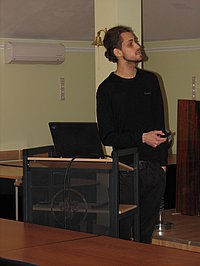Induced optical absorption in PLZT ceramics
PLZT is lanthanum modified lead zirconate-titanate high density optically transparent ceramic. PLZT has potential for application as the material for the electro-optical switches, optical scanners, variety of transducers and other applications.
It is known that PLZT ceramics contains several types of lattice defects, mainly vacancies and disordered atomic sites as well as interfacial layers between grains (grain boundaries). One of the possible origins of induced optical absorption is recharging of preexisting lattice defects. Therefore the research of induced absorption of PLZT is of interest. Induced absorption data contains information about electronic processes can give useful information about these processes and the nature of point defects responsible for absorption mentioned.
The present study is devoted to investigation of pulsed electron beam induced short lived absorption in temperature region from 90K to 700K. The short lived absorption reveals that in PLZT ceramics are several types of absorption centers with different stability. The induced absorption in spectral region 1eV -2eV at RT decay completely during ~4µs while decay of induced absorption in spectral region E>2eV is much slower. We consider that electron (Ti3+) polarons are responsible for short lived absorption in spectral region of 1eV-2eV while in region E>2eV electron Pb+ and possibly hole Pb3+ polarons and recharging of preexisting effects are responsible for short lived absorption. The analysis of kinetics rise front shows that in PLZT ceramics migration and re-trapping of induced charge carriers in several trapping centers takes place.
